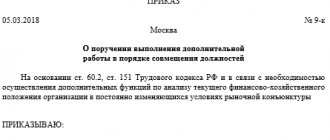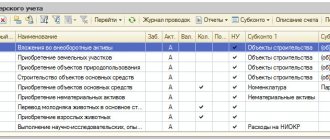Combining positions in one organization (internal combination) is a very common phenomenon today. It is used in conditions of insufficient volume of work to attract a new employee, the temporary nature of the work, the temporary absence of a full-time employee or the temporary absence of specialists of the required level; a good solution to problems for the employer can be combining positions.
In this regard, both employees and employers have a lot of questions about the procedure for registering such a work schedule, the specifics of payment and termination of combinations.
When is registration possible?
In contrast to the principles of part-time work, which prohibit accepting certain
category of workers for an additional workplace, the combination looks more democratic.
Labor legislation does not list positions or professions for which combinations are allowed. Consequently, there are no restrictions in this area for workers, unless otherwise stated in the Labor Code or federal legislation.
All restrictions are related to the principle of work activity of this type:
- An employee can obtain a combination of jobs from only one employer (within one enterprise, organization or institution).
- His additional work activity will be limited in time (you can work only during one shift or working day, without staying after your main job, that is, without working overtime).
- Only employees with sufficient professional skills and appropriate qualifications are allowed to work together.
At the same time, the procedure for providing a position or profession as a part-time workplace is initially laid down in the local documents of the organization or enterprise in order to avoid controversial issues in this area.
We can conclude that combination is not available to workers without proper qualifications or certain professional skills.
Leave a comment on the document
Do you think the document is incorrect? Leave a comment and we will correct the shortcomings. Without a comment, the rating will not be taken into account!
Thank you, your rating has been taken into account. The quality of documents will increase from your activity.
| Here you can leave a comment on the document “Sample agreement on combining positions”, as well as ask questions associated with it. If you would like to leave a comment with a rating , then you need to rate the document at the top of the page Reply for |
Design nuances
Additional work, as mentioned above, can only be obtained at one enterprise or in one organization or institution.
But this workplace is not necessarily located in the same building (building); however, the employer adheres to the principle of accessibility and proximity of workspaces for the employee who received the combination.
More often, similar (similar) positions are combined, but it is also possible to replace an absent colleague or hire a vacant position for another position. In this case, the availability of free space is confirmed by the timesheet and staffing table. According to the information contained in these documents, the reason for the employee’s absence and the possibility of replacing him with another employee are clear.
The scope of activity of a temporary deputy is determined by the nature of the position:
- If an employee takes a position in his profession, he will have to expand his responsibilities without a clear delineation of official powers.
- If an employee has received a position in a position other than his main job, he expands his responsibilities with a clear definition of the type and order of work performed.
It should be noted that the combination can be either urgent (time-limited) or indefinite.
In the latter case, there is a risk of termination of the employment relationship, since labor legislation allows the combination to be terminated at the request of one of the parties.
In this case, the interested party sends a written notice to the other party within three days, and then terminates the employment relationship.
The combination itself contains quite a lot of controversial issues, for which workers go to court for resolution. For example, disputes arose about the calculation of regional coefficients or whether the assigned additional payment corresponded to the volume of work performed.
What are the differences from part-time
Both of these categories assume that the employee performs work in addition to his main position in the organization, but are fundamentally different. Part-time work involves working in your free time from your main job. Chapter 44 of the Labor Code of the Russian Federation is devoted to the legal status of part-time workers, where it is established, for example:
- standard working hours;
- the procedure for granting leave to part-time workers;
- grounds for dismissal of a part-time worker.
If it is possible to combine positions only with the same employer, then they work part-time both in the same company and in another.
Registration procedure
Both parties can initiate the assignment of additional job responsibilities, but the basis for formalizing additional job responsibilities is always consent expressed in writing:
If the employer wants to entrust additional responsibilities, he sends the employee a memo with an offer to take the position. The employee must sign this document, expressing his consent, or refuse to sign.
If an employee wants to occupy a vacant workplace, he must submit an application to management with a corresponding request. On this document, the employer expresses his agreement or disagreement using a short summary.
Both of these forms of documents have legal force only after their agreement (approval by the interested parties).
These documents are the legal basis for issuing an order and signing an additional agreement (if we are talking about long-term combination).
The application is written in free form by hand. This document does not have a unified form.
Required items to fill out:
- An appeal to the employer indicating the name of the organization or enterprise, as well as the full name and position of the immediate supervisor.
- Indication of information about the employee submitting this document (his full name and title of position).
- A brief statement of the request indicating the position for which the employee is applying.
- Signature and date of preparation (submission) of the document.
The memo is also written by the employer in free form and includes the following points:
- Full name of the organization or enterprise, registration number of the document, full name of the employee and his position.
- Title of the document (combination proposal).
- A summary of the proposal describing the duties and responsibilities of the vacant or temporarily vacant position.
- Information on the amount of the established surcharge and the procedure for its provision.
- Signature of the manager and date of drawing up the memo.
After agreeing on all the nuances, the new employment relationship is documented, which includes two stages:
- Drawing up and signing of an additional agreement. This document is initially prepared by the HR department in two copies, one of which is handed over to the employee.
- Issuance of an appropriate order approving the amount of additional payment and changes in the staffing table. This document also serves as the basis for the calculation and payment of additional remuneration.
Comment on the rating
Thank you, your rating has been taken into account. You can also leave a comment on your rating.
Is the sample document useful?
If the document “Sample Agreement on Combining Positions” was useful to you, we ask you to leave a review about it.
Remember just 2 words:
Contract-Lawyer
And add Contract-Yurist.Ru to your bookmarks (Ctrl+D).
You will still need it!
Payment
Additional remuneration is calculated taking into account the current employment
legislation, namely Article of the Labor Code numbered 60.2, local documents (Regulations on payment adopted by an enterprise or organization), as well as the agreement reached by the parties (it is recorded in an additional agreement and order).
Such payment may be:
- Fixed, pre-established in local documents of an organization or enterprise.
- Depends on the volume of work performed. For example, a turner can be paid money based on the production of products.
- Depends on the nature of the additional duties performed. For example, for teachers who have taken on additional responsibilities as a class teacher, additional payment is made according to the hours worked.
Additional payment is guaranteed to employees who have taken on additional work responsibilities by Article 151 of the Labor Code.
Such payments are assigned both when combining positions and professions, implying:
- expansion of service area and responsibilities;
- increasing the volume of work performed without exemption from core activities.
Sample consent for combining positions
If you need to draw up an agreement to combine two positions, which you have never written before, read the explanations for the document given here and look at the example - using it, you can easily write your own document.
- At the beginning of the consent, indicate to whom you are addressing it: the name of the company, position and full name of the director (or the employee performing his duties).
- Next, enter your own data in the same way.
- After this, in the middle of the line write the word “Statement”, below - “on consent to combine two positions.”
- Next, formulate the main part. First of all, indicate when and by whom the combination was offered to you, then that you agree with this working regime.
- Be sure to indicate in your application the amount of remuneration agreed with management for the additional amount of work, as well as a link to the article of the Labor Code of the Russian Federation in accordance with which you are acting.
- At the end, do not forget to sign your consent.
Providing leave
Annual paid leave is not provided for a part-time position.
But at the same time, the employee is released from additional duties for the period of legal rest, issued in accordance with the vacation schedule established at the enterprise or organization.
When calculating vacation funds, the additional payment accrued for additional work is taken into account (according to Article 139 of the Labor Code).
Hiring a former civil servant and all the features of this event. Do you need to complete payroll transactions? Don't worry. All the details are in our article! Tariff payment - does it have another solution? You can read everything you need to know about him at this link.
Period
As a rule, the head of the organization strives to ensure that the staff is fully staffed and often looks for new employees. Therefore, the performance of additional duties assigned to an employee may be temporary. In addition, not every person can cope with a large amount of work in eight hours. Therefore, when assigning additional responsibilities to an employee, the boss, in the agreement attached to the main contract, prescribes the period of its validity.
You also need to know that the vacancy for which the combination is carried out is not considered occupied and must be offered to another person when laying off or when applying for employment at the enterprise.
Transfers, permanent and temporary
These types of personnel changes are another option to effectively use the professional potential of employees. Operations have much in common, but there are nuances that force the manager to be extremely careful in his choice. To avoid mistakes, the employer must rely on Art. 72.1 Labor Code of the Russian Federation. Resolution of the Plenum of the Supreme Court of the Russian Federation dated March 17, 2004 No. 2 will also be useful.
The main difference between the concepts under consideration is whether the employee’s job function or place of work changes. If so, this should be considered a transfer, and the employer must obtain the employee's consent to process it.
Permanent transfers include:
- transfer of an employee to another job with the same employer in the same area;
- change of structural unit in the case when what is specified in the TD changes to another in the same area;
- relocation of an employee together with an organization/branch to another location.
A special type is the transfer of an employee to another employer. In practice, it is often called “dismissal of an employee by transfer”.
There is a temporary transfer option for up to 1 year. In this case, the employee’s consent is also required. An employer can transfer his employee to another job without written consent for a period of no more than one month only in exceptional cases (Article 72.2 of the Labor Code of the Russian Federation):
- to prevent a natural or man-made disaster, industrial accident, industrial accident - in any exceptional cases that endanger human life and health;
- during downtime, if necessary, to prevent damage or destruction of property, to replace a temporarily absent employee, if this is dictated by emergency circumstances.
To formalize the transfer, enter into an additional agreement with the employee based on his application or a memo from his immediate supervisor with his, the employee’s, consent. The exception is the case of dismissal by transfer, when the new employer draws up its employment contract with the accepted employee. After the parties have signed the additional agreement/employment contract, an order is issued and information about the permanent transfer is entered into the work book.








